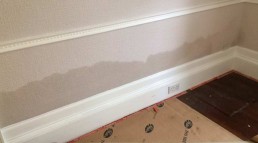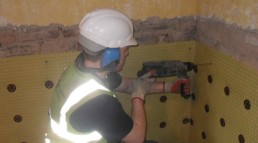Frequently Asked Questions About Damp Proofing
Damp is a common problem in homes affected by property defects, structural problems or poor ventilation. Left untreated, damp can cause major structural problems, potentially spoil interior decoration, furnishings and accelerate the growth of rot and mould within a property.
In this FAQ, we will explore the causes of damp affecting property, how to identify potential damp symptoms in your home and the different methods used to ensure a property is free from damp.
- Why is Damp Affecting Properties?
- What Causes Damp Walls?
- Assessing if You Have Damp Walls in Your Home
- Identifying Condensation on Walls
- Identifying Rising Damp on Walls
- Identifying Penetrating Damp on Walls
- What is a Damp Proof Course?
- How Do You Install a Damp Proof Course?
- Do All Properties Have a Damp Proof Course?
- What Are the Consequences of Not Having an Effective Damp Proof Course in Place?
- Do You Need to Remove Plaster to Damp Proof a Property?
- When Can I Carry Out Redecoration After the Damp Proof Course?
- What is a Damp Proofing Membrane?
- How Long is a Damp Proofing Guarantee?
- How Much Does It Cost to Damp Proof a Property?
Why is Damp Affecting Properties?
Damp is the unwanted ingress of water or moisture into a property. This is caused by either water or moisture coming in from outside the property due to property defects such as damaged masonry and roof structures or from inside the property itself, often due to a lack of efficient ventilation or burst pipes causing leaks.
These are some of the most common types of damp than can affect a property:
- Rising Damp
- Penetrating Damp
- Condensation
- Plumbing Leaks
- External Flooding
- Below Ground Damp
What Causes Damp Walls?
Damp walls are caused by water or moisture penetrating the external envelope of your property and affecting the fabric of your property. This moisture or water could also be created inside the property due to damaged plumbing or high air moisture content causing surface or interstitial condensation.
If you identify damp patches in your property, it is important you check inside and outside to find the source of the damp problem. Once the problem is located and measured, an effective remedial damp treatment can be applied to dampproof the area.

Assessing if You Have Damp Walls in Your Home
Unless there are obvious damp patches on walls, with plaster and paint crumbling or peeling off, it is often difficult to confirm the presence of structural damp. Professionals will be able to use specialised instruments such as Damp Meters, Hygrometers and Surface Thermometers to confirm the presence of damp.
The only non-visual way to confirm the presence of damp yourself is to place the back of your hand on the wall to compare the damp area with a dry one. While not accurate, it should be enough for you to confirm if the wall is affected by damp.
Identifying Condensation on Walls
Condensation forms when moisture laden air inside your property starts to cool down, which then condenses on surfaces withing the room. If the room is not properly ventilated or any contributing property defect are not repaired then areas frequently affected by condensation will soon start to germinate black mould, which is quite easy to identify visually.

Identifying Rising Damp on Walls
Rising damp is always located on the ground floor of a property. It sometimes can be identified by horizontal tidemarks that can be seen approximately one metre up from the floor. Areas affected by rising damp can also be affected by condensation and start to germinate black mould and mildew. If the area affected by rising damp is decorated, the paintwork can start to bubble and blister and if it is covered with a wallpaper, it can often start to peel off the damp wall. In some more severe cases, your wall might even demonstrate salt deposits, that are carried form the ground by the damp rising and make the wall further susceptible to damp from the atmosphere.
Identifying Penetrating Damp on Walls
Penetrating damp can occur at any point in a property and is generally caused by property defects. You might see watermarks on the interior and exterior of the property. Damaged masonry can absorb rainwater and allow the moisture to make its way to the interior of the building where these watermarks occur. Most often, the watermarks are more noticeable after heavy rainfall.

What is a Damp Proof Course?
A damp proof course (DPC) is a damp proof layer inserted into the masonry walls of a property when it is built and is generally 150 mm above the ground level. Damp from the ground can rise up the wall due to capillarity and affect the property fabric both inside and outside of the building.
How Do You Install a Damp Proof Course?
Several methods can be used to repair an existing damp proof course. The most common damp proofing method is to simply drill holes into the wall and inject a damp proofing cream that forms a damp proof layer. This damp proofing application is mostly used to damp masonry walls built of brick and stone.
Mortar injection DPC is a system that can be used on properties with walls that are filled with rubble stone. A special damp proofing mortar is injected at spaced drill holes round the property.
Another method of damp proofing is by installing an electro-osmosis system. Using this method, a slight electric charge is sent through the walls via wires grounded to the earth which then reverses the polarity of the capillarity in the walls and pulls the moisture back to the ground.
Do All Properties Have a Damp Proof Course?
Damp Proof Course installation has been a method used since the Victorian era. If you live in a property this old, it is possible you might not have one installed or it has severely degraded. All contemporary houses will have a DPC installed but over time these can fail or be bridged and the property may need some DPC remedial work to ensure that the Damp Proof Course is being effective and stopping Rising Damp from affecting the property.

What Are the Consequences of Not Having an Effective Damp Proof Course in Place?
A property that does not have an effective damp proof course in place is susceptible to undesirable Rising Damp. Moisture will be allowed to freely rise into a property causing deterioration to the property fabric and you may get secondary issues such as condensation and mould. This in turn can peel wallpaper and paint, disintegrate plaster and do serious harm to the integrity of the building. It is also important to know that any untreated or unprotected timber in your property that is affected by damp can start to rot and may lose its structural integrity as a result.
Do You Need to Remove Plaster to Damp Proof a Property?
Any walls affected by rising damp will also be affected by hygroscopic salts, nitrates and chlorides, that rise with the moisture from the ground. Plaster contaminated with these salts will require to be removed and replaced as the salts attract damp from the interior atmosphere of the property. This means that even if you fix your DPC and stop the moisture rising up the wall the Hygroscopic salts may keep the existing plaster damp.
To resolve this issue, our technicians will remove the contaminated plaster and repair the area using an appropriate renovating plaster or fit a damp proof membrane before re-plastering.
When Can I Carry Out Redecoration After the Damp Proof Course?
The first decorations should only be applied after the plaster has had time to dry. It is key to apply only water-based emulsion paint as the first decoration as this allows the walls to breathe and dry out. Walls affected by rising damp can take a long time to dry out, therefore it is important that moisture in the wall is able to evaporate.
What is a Damp Proofing Membrane?
Damp proofing membrane is a special plastic membrane that is directly applied to a damp wall. This membrane application prevents damp in the wall from affecting the new plasterwork as the damp wall dries out. A similar type of membrane is used in basement or cellar waterproofing, where the membrane will be used to create a cavity to the wall and stop water from the ground affecting the internal property fabric.

How Long is a Damp Proofing Guarantee?
At Richardson & Starling we believe in giving our customers a guarantee that they can trust and to give peace of mind that the job has been done properly. This is why we offer long-term guarantees on full remedial preservation treatments that we do.
We offer 30-year guarantees on rising damp, woodworm, dry and wet rot treatments. We also offer 10-year guarantees for basement waterproofing and 5-year guarantees on penetrating damp and timber window repairs.
How Much Does It Cost to Damp Proof a Property?
As every property is different with its own unique damp problems, it is difficult to give an exact cost of works without seeing the property. Only when a Richardson & Starling surveyor has assessed the property and determined the appropriate remedial specification will a quotation for the work be given.
Contact your local branch if you have any concerns about damp issues in your property.